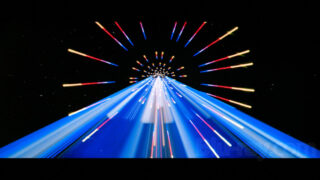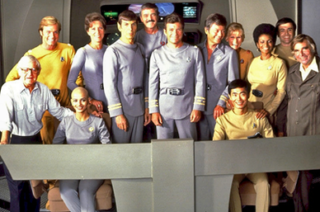
Palmer’s Trek: the final frontier. These are the voyages of Agent Palmer. On his continuing mission: to explore star trek. To seek out television series and movies. To boldly go where many fans have gone before!
Star Trek: The Motion Picture, the first large widescreen format of the Enterprise, first released in 1979. To this point, The Original Series and The Animated Series have been comforting and positive, if not downright enjoyable adventures throughout space under the banner of the Federation. Those two series also, at this point, represent all of my Trek experience.
But the jump to the big screen came with a few drawbacks for me. I have done very little research into this film, as I don’t want to see what others have said yet, and it’s unavoidable really.
So, let’s first talk about what I watched. I watched what was available to me, which was the Director’s Edition, which has 2022 credits in the end movie scroll. This, a friend has told me, is due to it finally becoming a 4K film. The director’s cut is only marginally longer than the original, but it’s best if we’re all on the same page as I explain my thoughts.
At the beginning, there’s a fairly long preamble with a great score where we’re just in a star field, for a couple minutes before we even see the Paramount logo. The widescreen starfield really lets you know that we’re not in television land anymore.
And since we’re not on the little box, let’s talk about all the new things for the franchise I saw in this film.
Two new languages; Klingon and Vulcan, new visuals, new uniforms, new titles for some old characters, new styles, and of course, a brand new and overhauled U.S.S. Enterprise. Let’s quickly go in order.

Engage Warp Drive
The two new languages are welcome. Having been all over many galaxies, universes, and planes of existence and even throughout history, it’s nice to finally have a few more languages. But neither are used enough in just this film for any further comment.
The new visuals are exciting. The computer graphics, while of the time in 1979, are still many times warp factor 7 ahead of the original series and even the animated series. The new Enterprise is interesting to say the least. Gone is the old ship that has already survived many previous adventures and here is a newly outfitted and retrofitted ship. And of course, the launch sequence culminating in the sunrise is a hero shot worthy of the U.S.S. Enterprise.
That ship, by the way, gets a few minutes of screen time all to itself as Kirk and Scotty take the scenic route to get onboard.
The old characters return with new titles – Dr. Chapel, Admiral Kirk, and the rest – and that’s just fantastic, but it’s the style that is more amazing. Scotty now sports a mustache that fits him really well. Dr. McCoy’s return to the ship in full beard made me want him to keep it for the entire movie, but serving on the Enterprise is like military service and as a doctor, he should probably get that beard taken care of, as he does. Spock, when we first meet him, looks like he’s channeling his inner Kwai Chang Caine from the 1972 series Kung Fu.
But there are two new design aesthetics that I did not like. First is, what appears to be, the Star Wars-inspired hallways of the new and improved Enterprise. Gone are the spacious hallways of the previous ship and here are the more cramped angular not-quite-squared-off hallways. Space, the final frontier, apparently means Space, you’re now upgrading to cramped corridors.
 The other thing I didn’t like was the uniforms. They seem odd, perhaps just because they are so vastly different after having gotten used to the two prior television series, the lack of color signifying rank or department seems odd. Everything now seems to be shades of gray or beige. And of course, there’s the short-sleeved version of the uniforms, which just makes the bridge of the Enterprise look like the bridge of the Love Boat.
The other thing I didn’t like was the uniforms. They seem odd, perhaps just because they are so vastly different after having gotten used to the two prior television series, the lack of color signifying rank or department seems odd. Everything now seems to be shades of gray or beige. And of course, there’s the short-sleeved version of the uniforms, which just makes the bridge of the Enterprise look like the bridge of the Love Boat.
It’s easy to fall into the story enough that those new threads don’t detract from what you’re seeing, but it would have been cool to have the classic OG Red, Blue, Gold, and Green uniforms. I understand they wanted to make it larger than life, but there was nothing wrong with the old threads.
Before I move on to the plot and the movie as a whole, let’s talk about the new bridge layout which seems, at best, inconvenient. While the movie doesn’t begin with “to explore strange new worlds” dialog from Kirk that kickstarted every episode of the two series before this movie, it is still a scientific vessel even if it is a warship. Having to literally turn around, even on a swivel chair to talk to your science officer seems tiresome for a captain who will indeed require much from his science officer in matters of exploration. Even if it’s just in this movie, it seems awkward.
The plot is, of course, an entity coming to destroy Earth. I wish Star Trek had avoided the Earth trope, just like all the disaster movies aim for New York, but here it is. And of course, Admiral James T. Kirk finds a way to resume command of the now overhauled USS Enterprise to help out, as it is the only ship with the capability to help in the vicinity.
The Earth bit aside, there are quite a few things in the plot and its conclusion that are amazing. The first is that when Spock discovers that this alien entity is using a new kind of energy. The writers resisted, in what is now a new trope, to first harness and then utilize that new energy for themselves. The second is where this movie completely overlaps with the two television series that precede it.
 Spoiler alert: In the conclusion, this alien entity V’Ger is just a computer built around Voyager IV, which was launched from Earth and built by humans and which just wants to complete its mission. In the movie, and even in the decades since, we are met with an overwhelming optimism for our future as a spacefaring species. At the time of its theatrical release only Voyagers 1 and 2 were launched by NASA in 1977 (I know this because I was reading Cosmos by Carl Sagan at the time I watched this film, so the overlap was hard to ignore). None of them have launched since. What bleeds into this movie from the television series is that the writers can’t help but be optimistic. In fact, at this time it appears optimism is in the DNA of the franchise, and it’s something I hope doesn’t change.
Spoiler alert: In the conclusion, this alien entity V’Ger is just a computer built around Voyager IV, which was launched from Earth and built by humans and which just wants to complete its mission. In the movie, and even in the decades since, we are met with an overwhelming optimism for our future as a spacefaring species. At the time of its theatrical release only Voyagers 1 and 2 were launched by NASA in 1977 (I know this because I was reading Cosmos by Carl Sagan at the time I watched this film, so the overlap was hard to ignore). None of them have launched since. What bleeds into this movie from the television series is that the writers can’t help but be optimistic. In fact, at this time it appears optimism is in the DNA of the franchise, and it’s something I hope doesn’t change.
And that writing is not only optimistic, it’s really brilliant. The philosophy of some of it has, of course, already been traversed a bit by the preceding series. There are some great points worthy of art and discussion, especially Spock’s line that “Each of us, at some time in our life, turns to someone, a father, a brother, a god and asks ‘Why am I here?’ ‘What was I meant to be?’ V’Ger hopes to touch its Creator to find its answers.”
For the structure of this film, it takes about 40 minutes into the film until we get our first Captain’s Log. This is a vast departure from the two preceding series where the Captain’s Log or a log of some kind from someone on the crew started each episode. So while it’s not at the top to welcome us in, it’s comforting to have it back anyway.
When it comes to favorites, I didn’t really have a favorite character from the two previous series because I enjoyed the crew as a whole. Here, in this film, though, Spock has some great lines. Still, now being on the other side of 40, it’s McCoy that I feel speaks for me.
One of the first things McCoy says is, “Well, Jim, I hear Chapel’s an M.D. now. Well, I’m gonna need a top nurse, not a doctor who’ll argue every little diagnosis with me. And …they’ve probably redesigned the whole sickbay, too. I know engineers. They love to change things.”

He doesn’t like the upgraded sickbay because, “It’s like working in a damned computer center.”
I don’t know if this is a controversial statement because this film has moments of greatness, but I believe the two-part Menagerie episode from Season One of The Original Series is a better film overall, had it been made into one. That’s, of course, if you are only going on plot. The graphics and widescreen make this movie larger than anything in the Star Trek franchise to date, and there is one other ingredient to this recipe that really makes this film sizzle: the music.
The music of Star Trek: The Motion Picture is a work of art. Jerry Goldsmith’s score is larger than life and yet it’s also vast enough to encompass the wide open spaces of, well, wide open space. It builds tension. It’s not the cheesy-but-fun soundtrack that has been the score of the television series, and it’s something I’ve found myself throwing on in the background as I work, just because. Sure, Goldsmith won’t replace John Willaims at the top of my list of score writers, but it’s up there.
Overall, I enjoyed this first foray into the widescreen world of motion pictures of the Star Trek franchise, and I look forward to what comes next.